2003 NISSAN X-TRAIL sensor
[x] Cancel search: sensorPage 33 of 3066
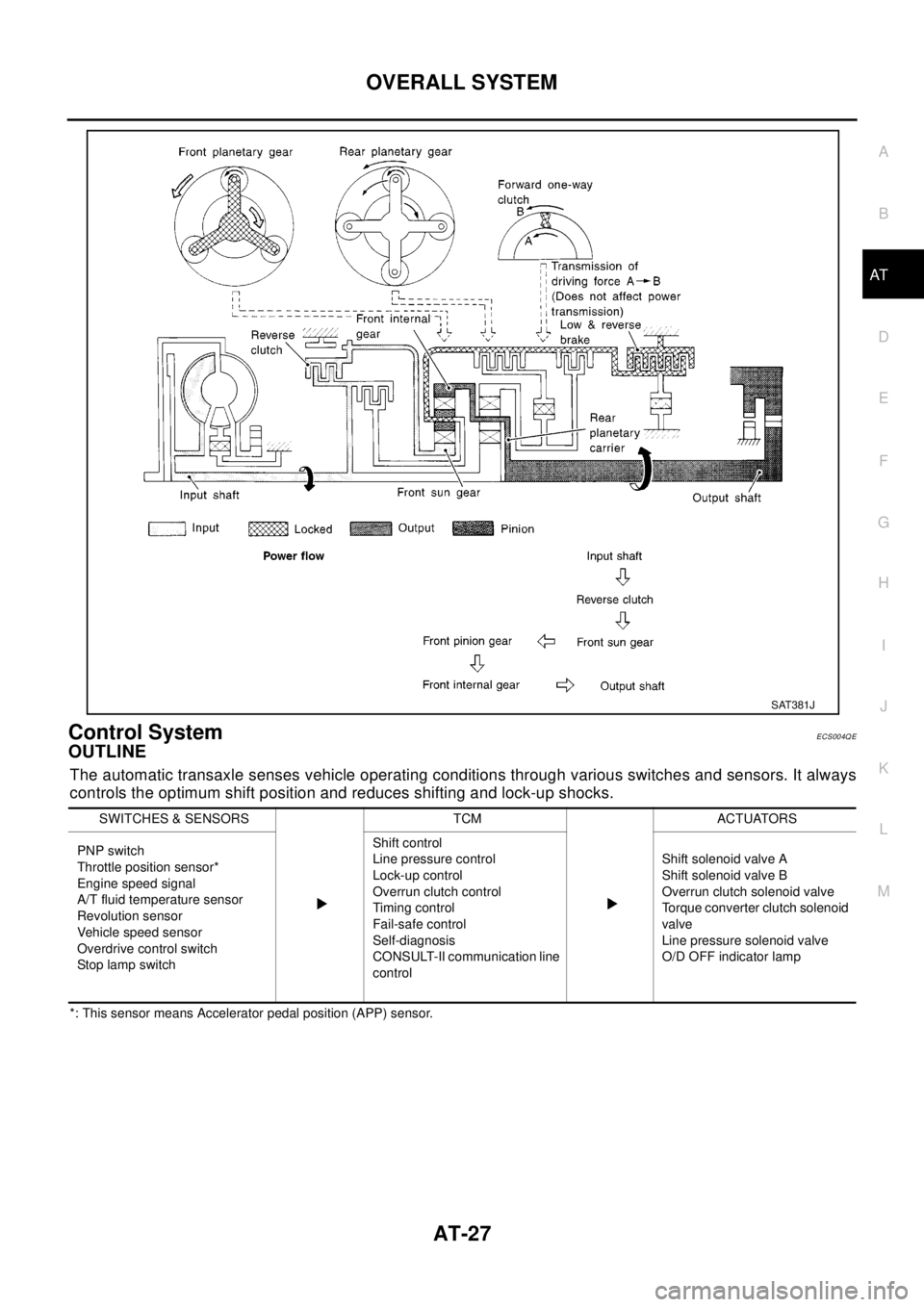
OVERALL SYSTEM
AT-27
D
E
F
G
H
I
J
K
L
MA
B
AT
Control SystemECS004QE
OUTLINE
The automatic transaxle senses vehicle operating conditions through various switches and sensors. It always
controls the optimum shift position and reduces shifting and lock-up shocks.
*: This sensor means Accelerator pedal position (APP) sensor.
SAT381J
SWITCHES & SENSORS TCM ACTUATORS
PNP switch
Throttle position sensor*
Engine speed signal
A/T fluid temperature sensor
Revolution sensor
Vehicle speed sensor
Overdrive control switch
Stop la mp s witchShift control
Line pressure control
Lock-up control
Overrunclutchcontrol
Timing control
Fail-safe control
Self-diagnosis
CONSULT-II communication line
controlShift solenoid valve A
Shift solenoid valve B
Overrun clutch solenoid valve
Torque converter clutch solenoid
valve
Line pressure solenoid valve
O/D OFF indicator lamp
Page 34 of 3066
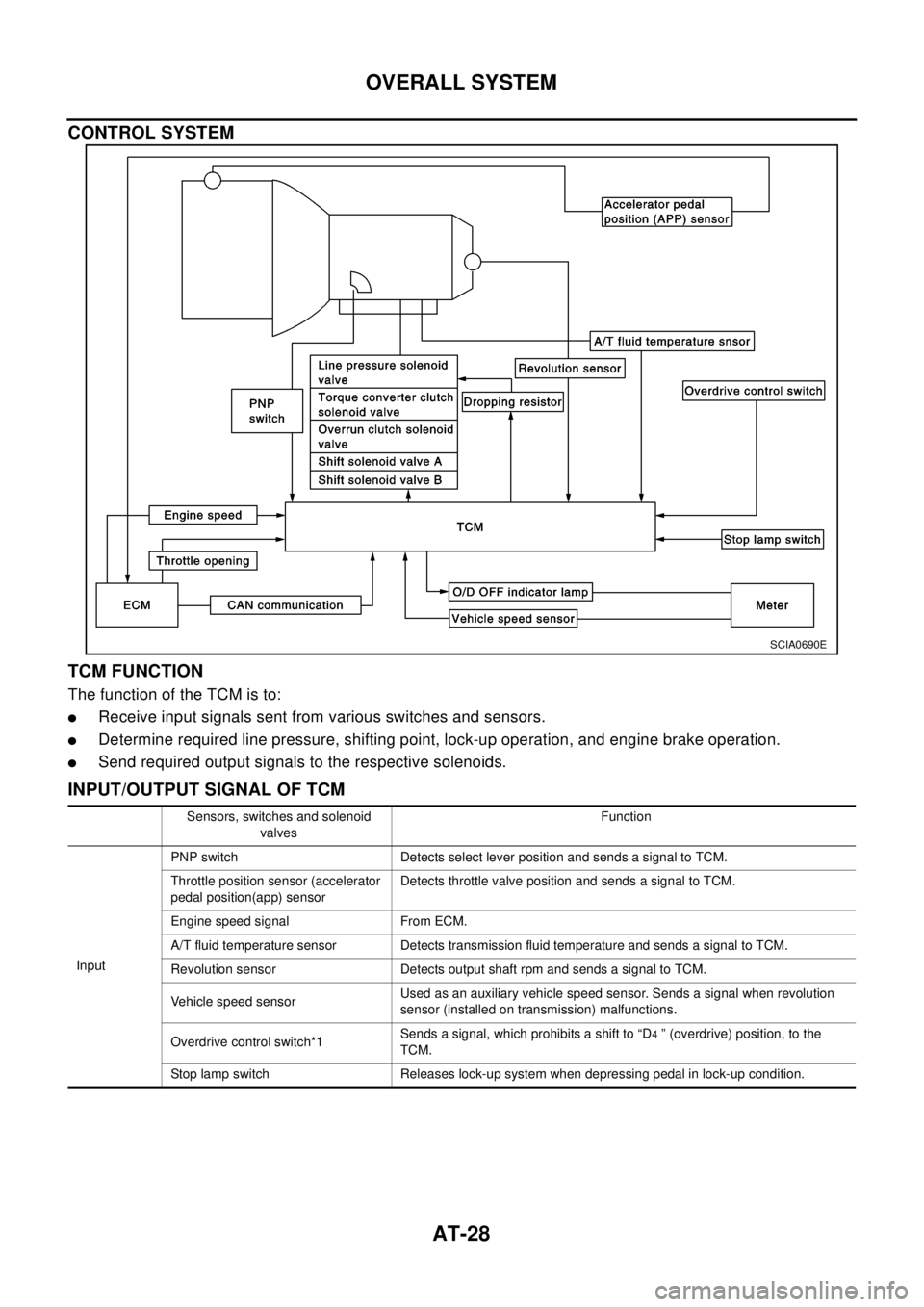
AT-28
OVERALL SYSTEM
CONTROL SYSTEM
TCM FUNCTION
ThefunctionoftheTCMisto:
lReceive input signals sent from various switches and sensors.
lDetermine required line pressure, shifting point, lock-up operation, and engine brake operation.
lSend required output signals to the respective solenoids.
INPUT/OUTPUT SIGNAL OF TCM
SCIA0690E
Sensors, switches and solenoid
valvesFunction
InputPNP switch Detects select lever position and sends a signal to TCM.
Throttle position sensor (accelerator
pedal position(app) sensorDetects throttle valve position and sends a signal to TCM.
Engine speed signal From ECM.
A/T fluid temperature sensor Detects transmission fluid temperature and sends a signal to TCM.
Revolution sensor Detects output shaft rpm and sends a signal to TCM.
Vehicle speed sensorUsed as an auxiliary vehicle speed sensor. Sends a signal when revolution
sensor (installed on transmission) malfunctions.
Overdrive control switch*1Sends a signal, which prohibits a shift to “D
4” (overdrive) position, to the
TCM.
Stop lamp switch Releases lock-up system when depressing pedal in lock-up condition.
Page 35 of 3066
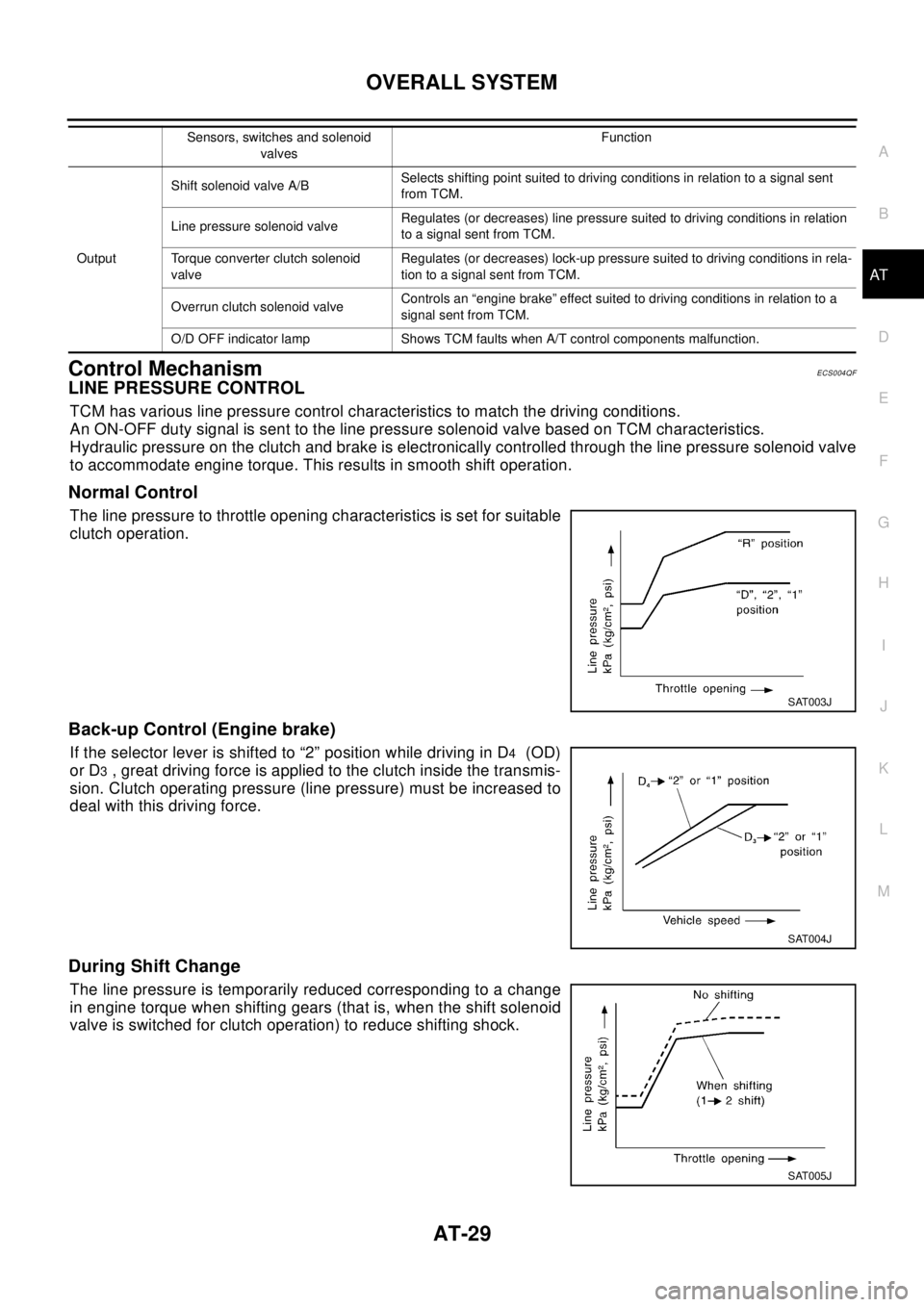
OVERALL SYSTEM
AT-29
D
E
F
G
H
I
J
K
L
MA
B
AT
Control MechanismECS004QF
LINE PRESSURE CONTROL
TCM has various line pressure control characteristics to match the driving conditions.
An ON-OFF duty signal is sent to the line pressure solenoid valve based on TCM characteristics.
Hydraulic pressure on the clutch and brake is electronically controlled through the line pressure solenoid valve
to accommodate engine torque. This results in smooth shift operation.
Normal Control
The line pressure to throttle opening characteristics is set for suitable
clutch operation.
Back-up Control (Engine brake)
If the selector lever is shifted to “2” position while driving in D4(OD)
or D
3, great driving force is applied to the clutch inside the transmis-
sion. Clutch operating pressure (line pressure) must be increased to
deal with this driving force.
During Shift Change
The line pressure is temporarily reduced corresponding to a change
in engine torque when shifting gears (that is, when the shift solenoid
valve is switched for clutch operation) to reduce shifting shock.
OutputShift solenoid valve A/BSelects shifting point suited to driving conditions in relation to a signal sent
from TCM.
Line pressure solenoid valveRegulates (or decreases) line pressure suited to driving conditions in relation
to a signal sent from TCM.
Torque converter clutch solenoid
valveRegulates (or decreases) lock-up pressure suited to driving conditions in rela-
tion to a signal sent from TCM.
Overrun clutch solenoid valveControls an “engine brake” effect suited to driving conditions in relation to a
signal sent from TCM.
O/D OFF indicator lamp Shows TCM faults when A/T control components malfunction.Sensors, switches and solenoid
valvesFunction
SAT003J
SAT004J
SAT005J
Page 36 of 3066
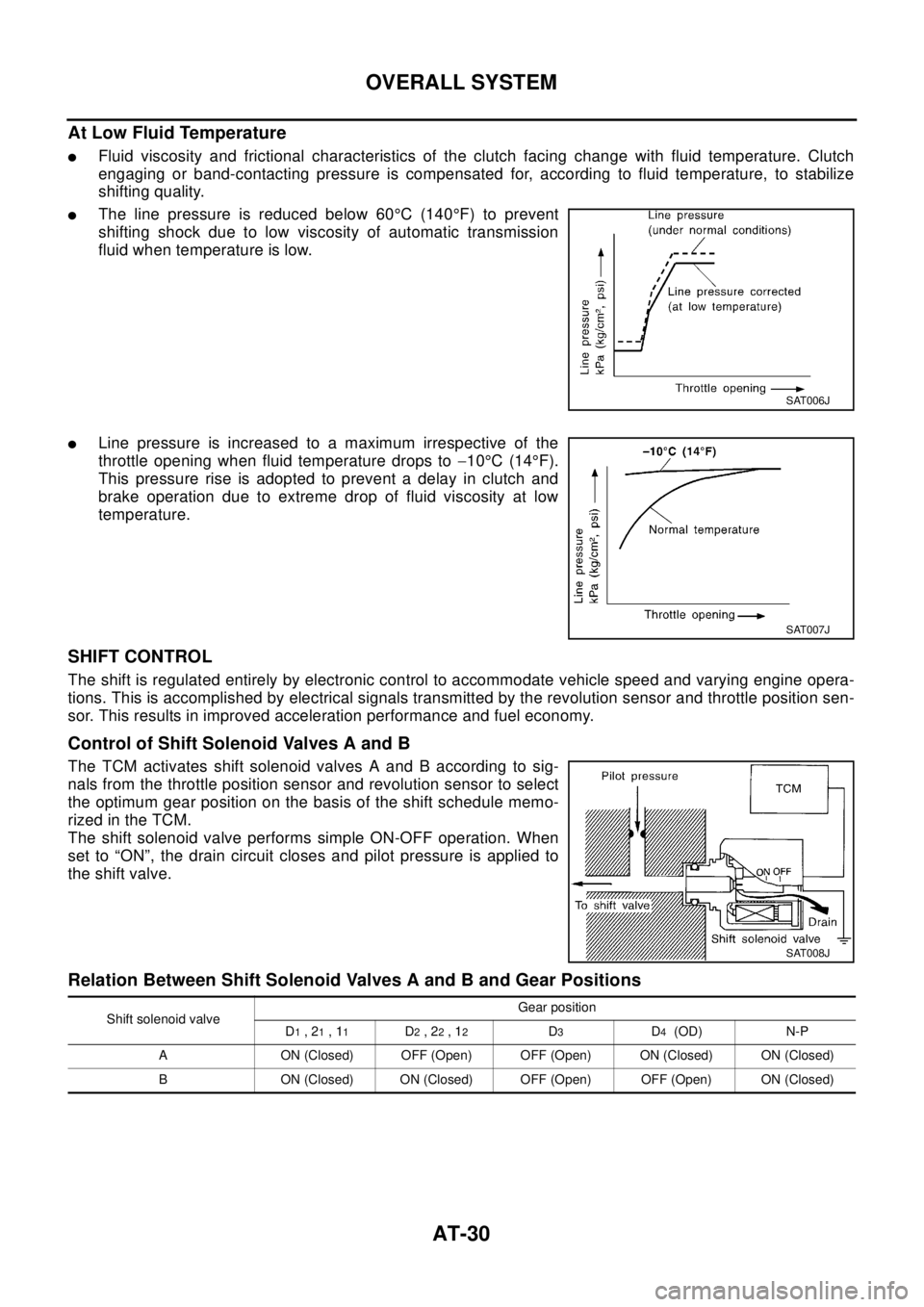
AT-30
OVERALL SYSTEM
At Low Fluid Temperature
lFluid viscosity and frictional characteristics of the clutch facing change with fluid temperature. Clutch
engaging or band-contacting pressure is compensated for, according to fluid temperature, to stabilize
shifting quality.
lThe line pressure is reduced below 60°C(140°F) to prevent
shifting shock due to low viscosity of automatic transmission
fluid when temperature is low.
lLine pressure is increased to a maximum irrespective of the
throttle opening when fluid temperature drops to-10°C(14°F).
This pressure rise is adopted to prevent a delay in clutch and
brake operation due to extreme drop of fluid viscosity at low
temperature.
SHIFT CONTROL
The shift is regulated entirely by electronic control to accommodate vehicle speed and varying engine opera-
tions. This is accomplished by electrical signals transmitted by the revolution sensor and throttle position sen-
sor. This results in improved acceleration performance and fuel economy.
Control of Shift Solenoid Valves A and B
The TCM activates shift solenoid valves A and B according to sig-
nals from the throttle position sensor and revolution sensor to select
the optimum gear position on the basis of the shift schedule memo-
rizedintheTCM.
The shift solenoid valve performs simple ON-OFF operation. When
set to “ON”, the drain circuit closes and pilot pressure is applied to
the shift valve.
Relation Between Shift Solenoid Valves A and B and Gear Positions
SAT006J
SAT007J
SAT008J
Shift solenoid valveGear position
D1,21,11D2,22,12D3D4(OD) N-P
A ON (Closed) OFF (Open) OFF (Open) ON (Closed) ON (Closed)
B ON (Closed) ON (Closed) OFF (Open) OFF (Open) ON (Closed)
Page 37 of 3066
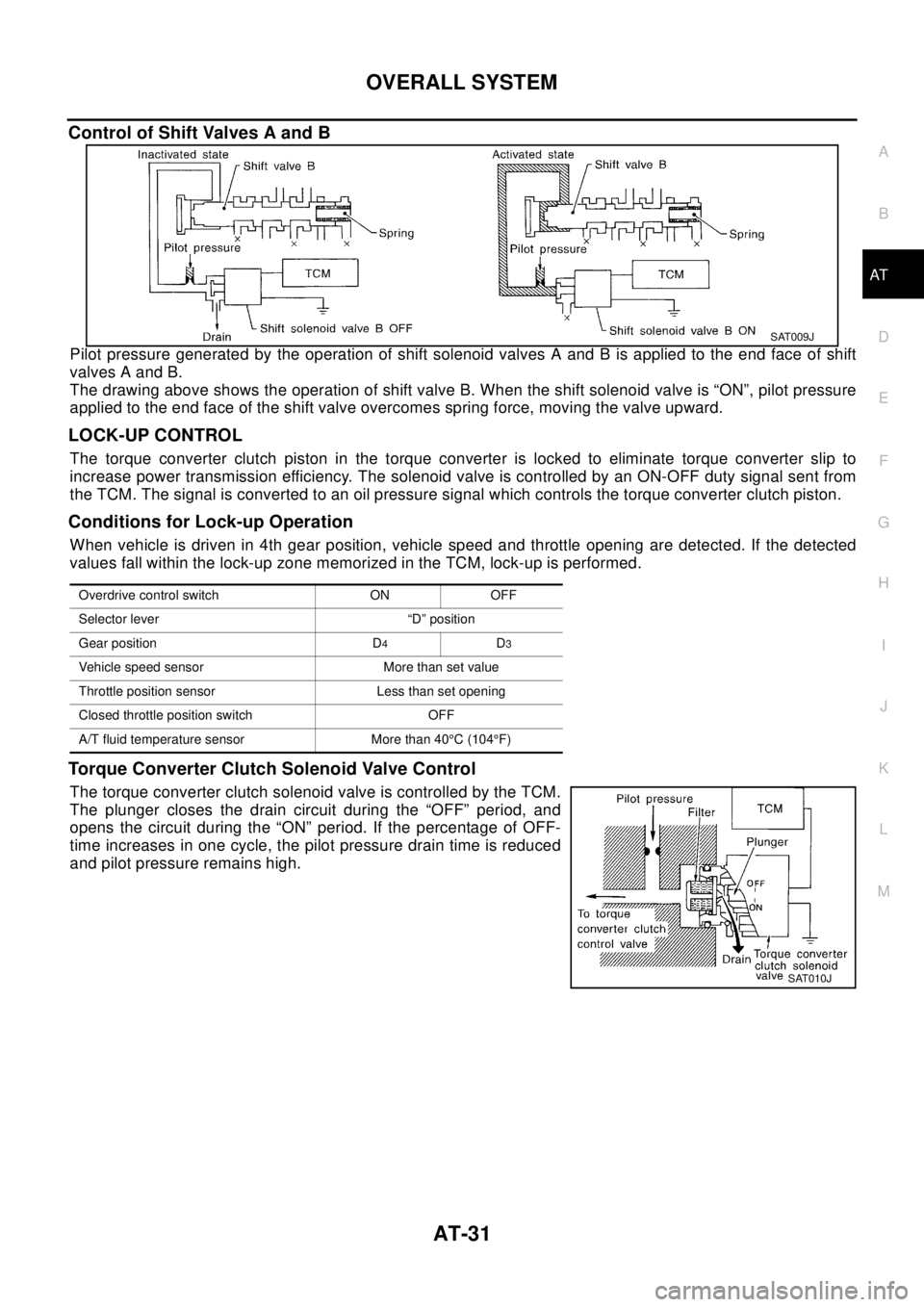
OVERALL SYSTEM
AT-31
D
E
F
G
H
I
J
K
L
MA
B
AT
Control of Shift Valves A and B
Pilot pressure generated by the operation of shift solenoid valves A and B is applied to the end face of shift
valves A and B.
The drawing above shows the operation of shift valve B. When the shift solenoid valve is “ON”, pilot pressure
applied to the end face of the shift valve overcomes spring force, moving the valve upward.
LOCK-UP CONTROL
The torque converter clutch piston in the torque converter is locked to eliminate torque converter slip to
increase power transmission efficiency. The solenoid valve is controlled by an ON-OFF duty signal sent from
the TCM. The signal is converted to an oil pressure signal which controls the torque converter clutch piston.
Conditions for Lock-up Operation
When vehicle is driven in 4th gear position, vehicle speed and throttle opening are detected. If the detected
values fall within the lock-up zone memorized in the TCM, lock-up is performed.
Torque Converter Clutch Solenoid Valve Control
The torque converter clutch solenoid valve is controlled by the TCM.
The plunger closes the drain circuit during the “OFF” period, and
opens the circuit during the “ON” period. If the percentage of OFF-
time increases in one cycle, the pilot pressure drain time is reduced
and pilot pressure remains high.
SAT009J
Overdrive control switch ON OFF
Selector lever “D” position
Gear position D
4D3
Vehicle speed sensor More than set value
Throttle position sensor Less than set opening
Closed throttle position switch OFF
A/T fluid temperature sensor More than 40°C(104°F)
SAT010J
Page 41 of 3066
![NISSAN X-TRAIL 2003 Electronic Repair Manual TROUBLE DIAGNOSIS — INDEX
AT-35
[EURO-OBD]
D
E
F
G
H
I
J
K
L
MA
B
AT
[EURO-OBD]TROUBLE DIAGNOSIS — INDEXPFP:00000
Alphabetical & P No. Index for DTCECS003VK
ALPHABETICAL INDEX FOR DTC
Check if the NISSAN X-TRAIL 2003 Electronic Repair Manual TROUBLE DIAGNOSIS — INDEX
AT-35
[EURO-OBD]
D
E
F
G
H
I
J
K
L
MA
B
AT
[EURO-OBD]TROUBLE DIAGNOSIS — INDEXPFP:00000
Alphabetical & P No. Index for DTCECS003VK
ALPHABETICAL INDEX FOR DTC
Check if the](/manual-img/5/57402/w960_57402-40.png)
TROUBLE DIAGNOSIS — INDEX
AT-35
[EURO-OBD]
D
E
F
G
H
I
J
K
L
MA
B
AT
[EURO-OBD]TROUBLE DIAGNOSIS — INDEXPFP:00000
Alphabetical & P No. Index for DTCECS003VK
ALPHABETICAL INDEX FOR DTC
Check if the vehicle is a model with Euro-OBD system or not by the “Type approval number” on the identifica-
tion plate. Refer toGI-45, "
IDENTIFICATION PLATE".
l*1: These numbers are prescribed by SAE J2012.
l*2: When the fail-safe operation occurs, the MIL illuminates.
l*3: The MIL illuminates when both the “Revolution sensor signal” and the “Vehicle speed sensor signal” meet the fail-safe condition at
thesametime.Type approval number Model
Available With Euro-OBD system
Not available (blank) Without Euro-OBD system
Items
(CONSULT-II screen terms)DTC
Reference page
CONSULT-II
GST*1
A/T 1ST GR FNCTN P0731AT- 1 5 1 , "
DTC P0731 A/T 1ST
GEAR FUNCTION"
A/T 2ND GR FNCTN P0732AT- 1 5 8 , "DTC P0732 A/T 2ND
GEAR FUNCTION"
A/T 3RD GR FNCTN P0733AT- 1 6 5 , "DTC P0733 A/T 3RD
GEAR FUNCTION"
A/T 4TH GR FNCTN P0734AT- 1 7 2 , "DTC P0734 A/T 4TH
GEAR FUNCTION"
ATF TEMP SEN/CIRC P0710AT- 1 3 6 , "
DTC P0710 A/T FLUID
TEMPERATURE SENSOR
CIRCUIT"
ENGINE SPEED SIG P0725AT- 1 4 7 , "DTC P0725 ENGINE
SPEED SIGNAL"
L/PRESS SOL/CIRC P0745AT-186, "
DTC P0745 LINE
PRESSURE SOLENOID
VA LV E"
O/R CLTCH SOL/CIRC P1760AT- 2 0 8 , "
DTC P1760 OVER-
RUN CLUTCH SOLENOID
VA LV E"
PNP SW/CIRC P0705AT-1 3 0 , "
DTC P0705 PARK/
NEUTRAL POSITION (PNP)
SWITCH"
SFT SOL A/CIRC*2 P0750AT- 1 9 3 , "DTC P0750 SHIFT
SOLENOID VALVE A"
SFT SOL B/CIRC*2 P0755AT- 1 9 8 , "DTC P0755 SHIFT
SOLENOID VALVE B"
TCC SOLENOID/CIRC P0740AT-181, "
DTC P0740 TORQUE
CONVERTER CLUTCH SOLE-
NOID VALVE"
TP SEN/CIRC A/T*2 P1705AT- 2 0 3 , "
DTC P1705 ACCEL-
ERATOR PEDAL POSITION
(APP) SENSOR"
VEH SPD SEN/CIR AT*3 P0720AT-142, "
DTC P0720 VEHICLE
SPEED SENSOR·A/T (REVO-
LUTION SENSOR)"
CAN COMM CIRCUIT U1000EC-114, "DTC U1000 CAN
COMMUNICATION LINE"
Page 42 of 3066
![NISSAN X-TRAIL 2003 Electronic Repair Manual AT-36
[EURO-OBD]
TROUBLE DIAGNOSIS — INDEX
PNO.INDEXFORDTC
Check if the vehicle is a model with Euro-OBD system or not by the “Type approval number” on the identifica-
tion plate. Refer toGI-45, NISSAN X-TRAIL 2003 Electronic Repair Manual AT-36
[EURO-OBD]
TROUBLE DIAGNOSIS — INDEX
PNO.INDEXFORDTC
Check if the vehicle is a model with Euro-OBD system or not by the “Type approval number” on the identifica-
tion plate. Refer toGI-45,](/manual-img/5/57402/w960_57402-41.png)
AT-36
[EURO-OBD]
TROUBLE DIAGNOSIS — INDEX
PNO.INDEXFORDTC
Check if the vehicle is a model with Euro-OBD system or not by the “Type approval number” on the identifica-
tion plate. Refer toGI-45, "
IDENTIFICATION PLATE".
l*1: These numbers are prescribed by SAE J2012.
l*2: When the fail-safe operation occurs, the MIL illuminates.
l*3: The MIL illuminates when both the “Revolution sensor signal” and the “Vehicle speed sensor signal” meet the fail-safe condition at
thesametime.Type approval number Model
Available With Euro-OBD system
Not available (blank) Without Euro-OBD system
DTC
Items
(CONSULT-II screen terms)Reference page
CONSULT-II
GST*1
P0705 PNP SW/CIRCAT- 1 3 0 , "
DTC P0705 PARK/
NEUTRAL POSITION (PNP)
SWITCH"
P0710 ATF TEMP SEN/CIRCAT-136, "
DTC P0710 A/T FLUID
TEMPERATURE SENSOR
CIRCUIT"
P0720 VEH SPD SEN/CIR AT*3AT- 1 4 2 , "
DTC P0720 VEHICLE
SPEED SENSOR·A/T (REVO-
LUTION SENSOR)"
P0725 ENGINE SPEED SIGAT- 1 4 7 , "DTC P0725 ENGINE
SPEED SIGNAL"
P0731 A/T 1ST GR FNCTNAT- 1 5 1 , "DTC P0731 A/T 1ST
GEAR FUNCTION"
P0732 A/T 2ND GR FNCTNAT- 1 5 8 , "DTC P0732 A/T 2ND
GEAR FUNCTION"
P0733 A/T 3RD GR FNCTNAT- 1 6 5 , "DTC P0733 A/T 3RD
GEAR FUNCTION"
P0734 A/T 4TH GR FNCTNAT- 1 7 2 , "DTC P0734 A/T 4TH
GEAR FUNCTION"
P0740 TCC SOLENOID/CIRCAT- 1 8 1 , "
DTC P0740 TORQUE
CONVERTER CLUTCH SOLE-
NOID VALVE"
P0745 L/PRESS SOL/CIRCAT-186, "
DTC P0745 LINE
PRESSURE SOLENOID
VA LV E"
P0750 SFT SOL A/CIRC*2AT-193, "DTC P0750 SHIFT
SOLENOID VALVE A"
P0755 SFT SOL B/CIRC*2AT-198, "DTC P0755 SHIFT
SOLENOID VALVE B"
P1705 TP SEN/CIRC A/T*2AT- 2 0 3 , "
DTC P1705 ACCEL-
ERATOR PEDAL POSITION
(APP) SENSOR"
P1760 O/R CLTCH SOL/CIRCAT-208, "
DTC P1760 OVER-
RUNCLUTCHSOLENOID
VA LV E"
U1000 CAN COMM CIRCUITEC-114, "DTC U1000 CAN
COMMUNICATION LINE"
Page 43 of 3066
![NISSAN X-TRAIL 2003 Electronic Repair Manual ON BOARD DIAGNOSTIC SYSTEM DESCRIPTION
AT-37
[EURO-OBD]
D
E
F
G
H
I
J
K
L
MA
B
AT
ON BOARD DIAGNOSTIC SYSTEM DESCRIPTIONPFP:00000
IntroductionECS004QH
The A/T system has two self-diagnostic systems.
T NISSAN X-TRAIL 2003 Electronic Repair Manual ON BOARD DIAGNOSTIC SYSTEM DESCRIPTION
AT-37
[EURO-OBD]
D
E
F
G
H
I
J
K
L
MA
B
AT
ON BOARD DIAGNOSTIC SYSTEM DESCRIPTIONPFP:00000
IntroductionECS004QH
The A/T system has two self-diagnostic systems.
T](/manual-img/5/57402/w960_57402-42.png)
ON BOARD DIAGNOSTIC SYSTEM DESCRIPTION
AT-37
[EURO-OBD]
D
E
F
G
H
I
J
K
L
MA
B
AT
ON BOARD DIAGNOSTIC SYSTEM DESCRIPTIONPFP:00000
IntroductionECS004QH
The A/T system has two self-diagnostic systems.
The first is the emission-related on board diagnostic system (EURO-OBD) performed by the TCM in combina-
tion with the ECM. The malfunction is indicated by the MIL (malfunction indicator lamp) and is stored as a DTC
in the ECM memory but not the TCM memory.
The second is the TCM original self-diagnosis indicated by the O/D OFF indicator lamp. The malfunction is
stored in the TCM memory. The detected items are overlapped with EURO-OBD self-diagnostic items. For
detail, refer toAT - 4 2 , "
SELF-DIAGNOSTIC RESULT TEST MODE".
EURO-OBD Function for A/T SystemECS004QI
The ECM provides emission-related on board diagnostic (EURO-OBD) functions for the A/T system. One
function is to receive a signal from the TCM used with EURO-OBD-related parts of the A/T system. The signal
is sent to the ECM when a malfunction occurs in the corresponding EURO-OBD-related part. The other func-
tion is to indicate a diagnostic result by means of the MIL (malfunction indicator lamp) on the instrument panel.
Sensors, switches and solenoid valves are used as sensing elements.
The MIL automatically illuminates in One or Two Trip Detection Logic when a malfunction is sensed in relation
to A/T system parts.
One or Two Trip Detection Logic of EURO-OBDECS0 04 QJ
ONETRIPDETECTIONLOGIC
If a malfunction is sensed during the first test drive, the MIL will illuminate and the malfunction will be stored in
the ECM memory as a DTC. The TCM is not provided with such a memory function.
TWO TRIP DETECTION LOGIC
When a malfunction is sensed during the first test drive, it is stored in the ECM memory as a 1st trip DTC
(diagnostic trouble code) or 1st trip freeze frame data. At this point, the MIL will not illuminate. — First Trip
If the same malfunction as that experienced during the first test drive is sensed during the second test drive,
the MIL will illuminate. — Second Trip
A/T-related parts for which the MIL illuminates during the first or second test drive are listed below.
The “trip” in the “One or Two Trip Detection Logic” means a driving mode in which self-diagnosis is performed
during vehicle operation.
EURO-OBD Diagnostic Trouble Code (DTC)ECS004QK
HOW TO READ DTC AND 1ST TRIP DTC
DTC and 1st trip DTC can be read by the following methods.
(withCONSULT-IIor GST)CONSULT-II or GST (Generic Scan Tool) Examples: P0705, P0710,
P0720, P0725, etc.
These DTCs are prescribed by SAE J2012.
(CONSULT-II also displays the malfunctioning component or system.)
l1st trip DTC No. is the same as DTC No.
lOutput of the diagnostic trouble code indicates that the indicated circuit has a malfunction. How-
ever, in case of the Mode II and GST they do not indicate whether the malfunction is still occurring
or occurred in the past and returned to normal.
CONSULT-II can identify them as shown below. Therefore, using CONSULT-II (if available) is rec-
ommended.
ItemsMIL
One trip detection Two trip detection
Shift solenoid valve A — DTC: P0750 X
Shift solenoid valve B — DTC: P0755 X
Throttle position sensor — DTC: P1705 X
Except aboveX